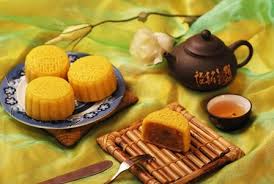Mooncakes
Posted by Selina Law on Aug 24th 2016
In preparation for our celebrations of the Chinese Moon (or Mid-Autumn) Festival, let us learn about THE staple dessert of the Festival—the mooncake (月餅 yuèbǐng)!
The modern concept of mooncake is believed to have been evolved from a Shang dynasty (17th century BC - 1046 BC) dessert, and the name “mooncake” was first used in the Tang dynasty (618 - 907 AD). However, it was not until the Ming Dynasty (1368 - 1644 AD) that the custom of eating this dessert during the Moon/Mid-Autumn Festival was formed. Besides eating the mooncakes, during the Festival people may also sacrifice them to the moon as offerings, and present them to relatives and friends for good wishes.
When we talk about mooncake, what people usually think of is Cantonese/Guangzhou-style mooncakes. This type of mooncakes is not only popular in the South of China, in particular its origin the Guangdong Province, but all over the world. It is also the most commonly seen type of mooncakes in North America and many Western countries. These mooncakes have a chewy crust with a reddish-brown tone and glossy sheen. The fillings feature various ingredients such as lotus seed paste, red bean paste, melon seed paste, ham, roasted pork, nuts, and salted egg yolks, to just name a few.
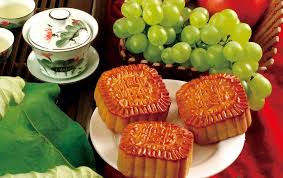
Besides the most well-known Cantonese-style mooncakes, different geographic regions or countries have their own unique styles of mooncakes. Let us look at some of them here:
Beijing-style: Claiming origin from Beijing, Tianjin and surrounding areas, it is representative of northern mooncakes. The most popular variations are the red Zilaihong (made with red sugar) and white Zilaibai (made with white sugar). They taste crispy outside, soft inside and not too sweet as a whole. Some of the common ingredients used include rock sugar, walnut pieces, pumpkin seeds, and candied tangerine peel slices.
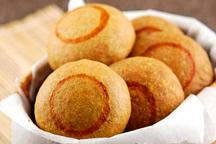
Suzhou-style: This style began more than a thousand years ago and is known for its
layers of flaky dough and generous allotment of sugar and
lard. Within this regional type, there are more than a dozen variations. It is
also smaller than most other regional varieties. Suzhou-style mooncakes feature both
sweet and savory types. The sweet ones are
usually stuffed with roses, osmanthus flowers, sesame, walnuts and sunflower
seeds; the savory ones are usually filled with ham, pork, shrimps, and lard,
and are served hot.
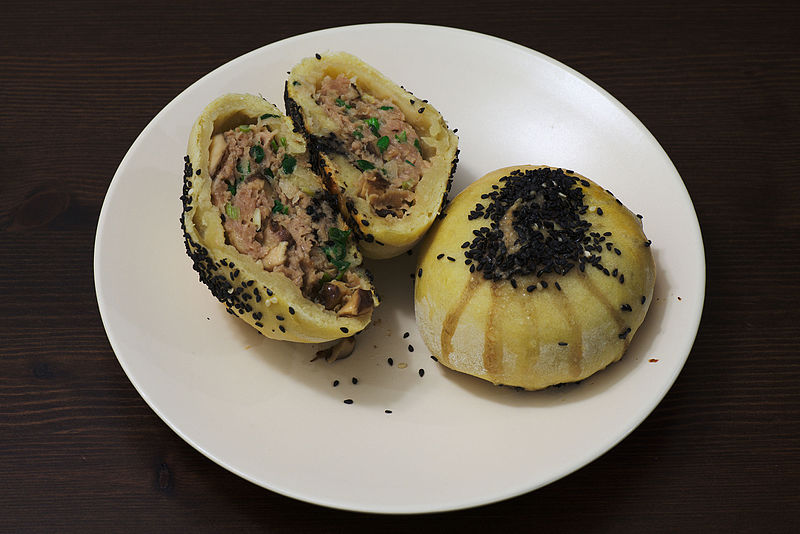
Yunnan-style: Originated and popular in the Yunnan and Guizhou area.
Its crust is loose and soft, and the main feature is the Yunnan-style ham in
the fillings. In certain variations, a unique blend of edibles
flowers (e.g. roses, jasmine or chrysanthemum) is put into the pastry.
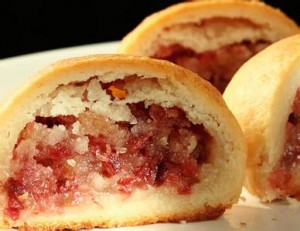
Huizhou-style: Huizhou here refers to modern-day Huangshan City and
Jixi County in Anhui Province, and Wuyuan
County in Jiangxi Province. The
crust is made from wheat flour and vegetable oil, and the fillings consist of
edible wild vegetables, lard, sugar, and black sesame, etc.
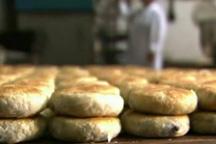
Chaozhou-style: Originally a local product of Chaozhou City in
Guangdong Province, it has a thin crust with a spiral-shaped pattern. Lard is
one of its major ingredients.
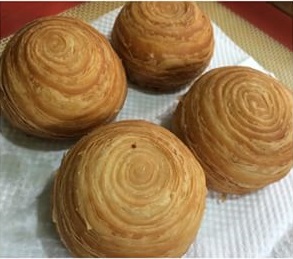
Indonesia: In Indonesia,
there are hundreds of types of mooncakes, from
the traditional to the modern ones. The very traditional mooncakes have been
there ever since the Chinese and Japanese entered Indonesia. The modern ones appeared in the market after 1998. Their mooncakes are circular
like a moon, white and rather thin. Fillings may include pork, chocolate,
cheese, milk, durian, jackfruit and many other exotic fruits. Before 1998, mooncakes were only sold in small markets or villages. Now the
traditional mooncakes are easy to find in supermarkets and mini-marts.
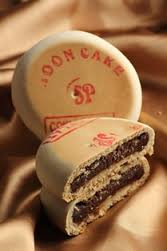
Japan: Mooncakes in Japan are known as geppei (月餅), a direct
translation of the Chinese name. They are associated with Chinese culture and
are sold all year round, mainly in Japan's Chinatowns.
Azuki (red bean)
paste is the most popular filling for these mooncakes, but other sorts of beans
as well as chestnut are also used. Unlike some types of Chinese mooncakes,
mooncakes in Japan very seldom contain any egg yolk in the center.
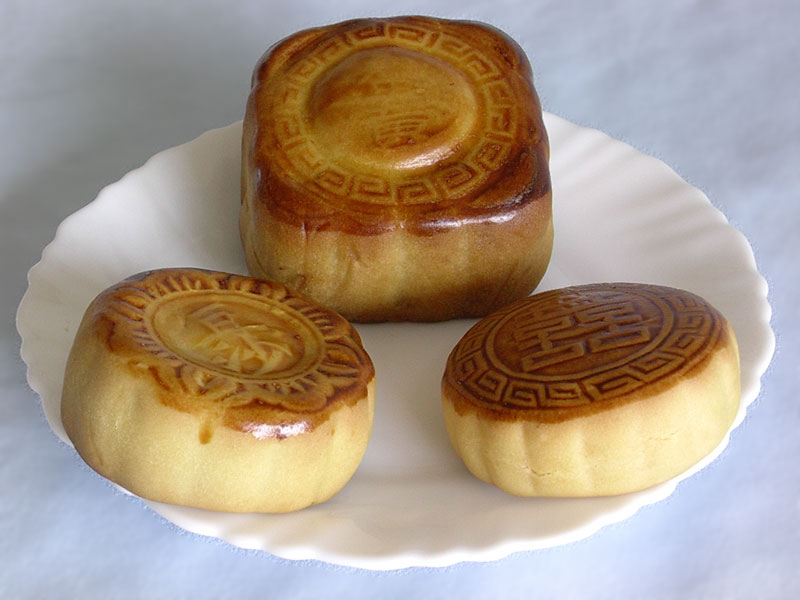
Vietnam: In Vietnam, mooncakes are known as Bánh Trung Thu (literally
"Mid-Autumn cake"). Vietnamese mooncakes are usually sold either
individually or in a set of four. There are two kinds of mooncake: "Bánh
nướng" (baked mooncake) and "Bánh dẻo" (sticky rice mooncake). They
are widely popular and are sold year-round. Their designs largely resemble that
of their Chinese counterpart, though some other images, such as the sow with
cub, fish, shrimp, etc. can also be found.
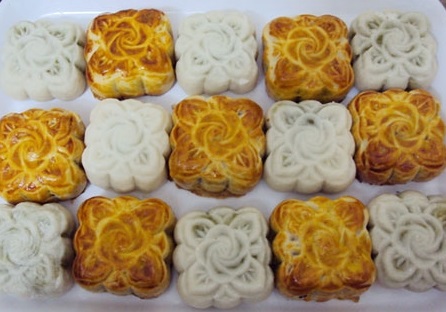
More types of mooncakes
have been created in recent years, such as sugar-free, ice cream, chocolate, tea,
fruit, vegetable, vegetarian, flower, coarse cereals
and edible fungi. Some other new creations include bamboo charcoal mooncakes and the no-baked snow skin.
As indicated by its name, edible bamboo charcoal is used during the cooking process, usually in the crust, so the bamboo charcoal mooncakes are generally black.
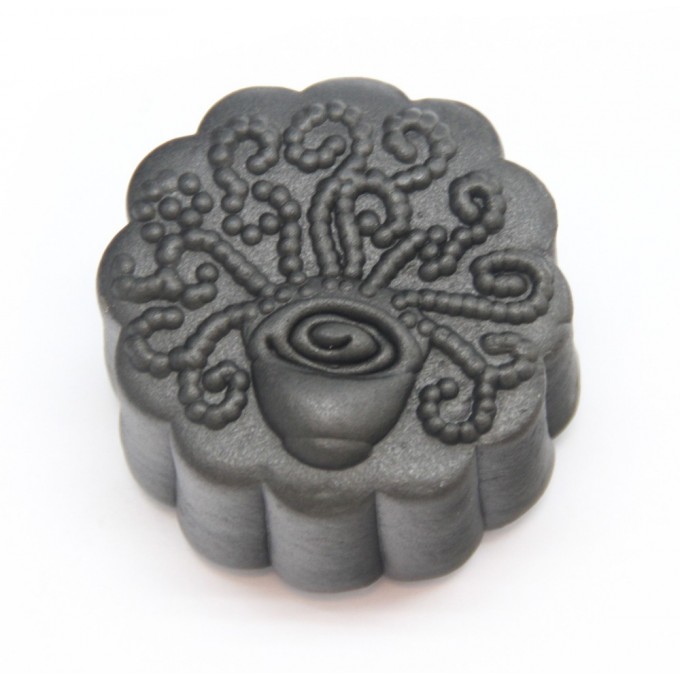
Bamboo Charcoal Rose
Tea Lotus Paste Mooncake
Snow skin mooncakes are non-baked mooncakes, which originated in Hong Kong, and have become fashionable in China and other places. The crust is made of frozen glutinous rice and looks snow white. Some people add juice to the crust to make it look more colorful. The fillings can be sweet or savory, or both, such as fruit and salted duck egg yolks. This style of mooncakes tastes better chilled.
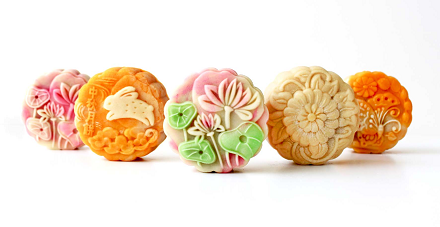
Snow skin mooncakes by The Cookie Museum, Singapore
For more photos and information on
different kinds of mooncakes, please go to our
Pinterest and Instagram pages.
Mooncakes are usually enjoyed with a cup of tea.


